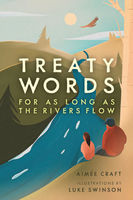Treaty Words Author Aimée Craft on Why She Wants Her Young Readers to Know They are "Part of Something Bigger Than Them"
At the heart of Anishinaabe/Métis lawyer Aimée Craft's wise and engaging Treaty Words: For As Long As the Rivers Flow (Annick Press, illustrated by Luke Swinson) is a question: Just what is a treaty? What does it mean to make an agreement – a sacred promise – and to honour that everyday going forward?
Mishomis teaches his granddaughter the answers to those questions in Treaty Words, showing her how to listen, to find her place in the world, and to understand the enduring bond that a treaty is. A keen and important insight into the Indigenous perspective on treaties, Treaty Words is brought even more vividly to life by Swinson's beautiful and gently meditative artwork.
We're thrilled to have Aimée with us today to talk about the book as part of our Kids Club series, where we speak to writers of books for young people. She tells us about an intense afternoon communing with nature that led to the idea for the book, why it's important for young readers to understand "they are part of something bigger than them", and how the young people in her life are an integral part of her writing process.
Open Book:
Tell us about your new book and how it came to be.
Aimée Craft:
The intent of the book, which is to understand what good relationships are and the principles that Indigenous people observed as part of building good treaty relationships, came from listening to the land and water. Laying by a lake on a rock for a whole afternoon I listened to the ice, pop, crack and then turn to musical crystals before the ice regained its water form. It reminded that if we listen, and take time, we can learn so much from our natural environments. For about seven years I carried that story with me. And one day, Prairie Fire magazine put a call out for a special edition NDN Country. I knew the story needed to be written. And then a year or so later Mary Beth Leatherdale from Annick Press contacted me and asked me if I wanted the story to become a children’s book. As it turns out, I think this is exactly how the story should be told.
OB:
Is there a message you hope kids might take away from reading your book?
AC:
I would like young readers to understand that they are part of something bigger than them. They have a whole world of relatives that are looking after them. In addition to your family, your friends, your teachers, your coaches, mother earth and all other beings that are part of creation are part of sustaining life. They’ve done it for much longer than we have and we have so much to learn from them. I also want them to think about how good relations between Indigenous peoples and settlers can be modelled – on concepts of reciprocity, respect and renewal. In many ways this book is about environmental and social consciousness.
OB:
Is there a character in your book that you relate to? If so, in what ways are you similar to your character and in what ways are you different?
AC:
The young girl in the book is a reflection of part of myself. She loves her land and learns about it through listening and relationships. She is at an amazing age when anything seems possible, you learn so much and you have the time and energy to learn. I also love this character because she loves her grandfather so much. They are a team. You see that in the words and imagery.
Your CanLit News
Subscribe to Open Book’s newsletter to get local book events, literary content, writing tips, and more in your inbox
OB:
What do you need in order to write – in terms of space, food, rituals, writing instruments?
AC:
I need to tell the story out loud for it to really take shape. Telling the little people in my life these stories, in this oral form allows me to see what parts of the story are solid, which ones need more work and to rely on some ancestral guidance. When you tell a story, it is out in the universe. I like the idea of reading to each other and being in relationship with, to and around a story. So a good story book will be equally pleasant to read, to hear, and ideally to see through beautiful illustrations for Treaty Words by artist Luke Swinson.
OB:
What are you working on now?
AC:
I’m currently working on a book about water teachings. You may recognize one of the characters. But you will also meet some new, interesting, imperfect, beautiful and kind people with big hearts.
________________________________________
Aimée Craft is an Anishinaabe/Métis lawyer from Treaty 1 territory in Manitoba. She is an Associate Professor at the Faculty of Common Law, University of Ottawa and a leading researcher on Indigenous laws, treaties, and water.





